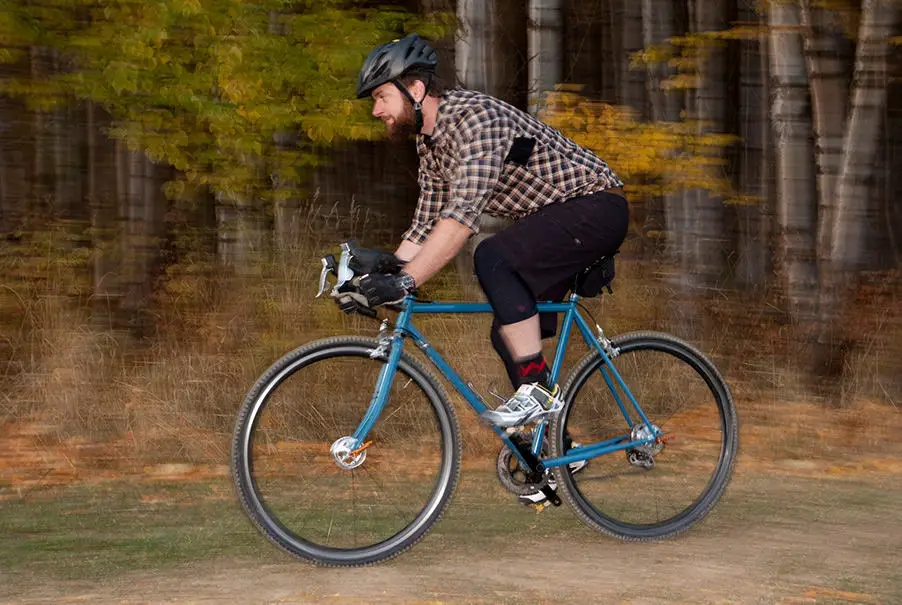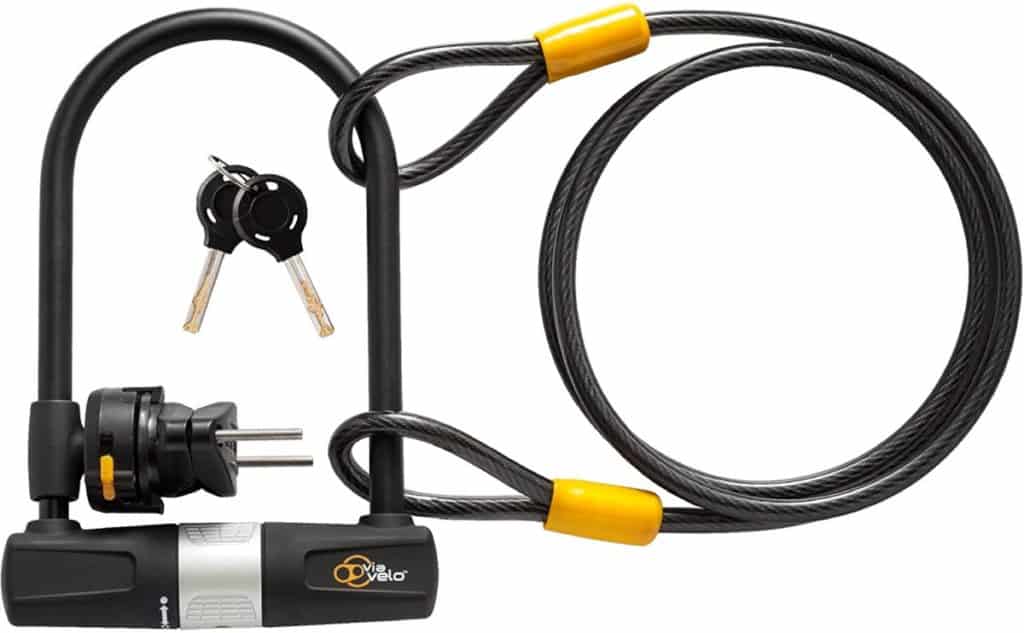
Did you know that together, the people of Copenhagen bike the equivalent of 35 times around the globe each day? Commuting by bike is healthy, inexpensive, and good for the environment, so it’s not a surprise that it’s increasingly popular everywhere. But what kinds of bikes can you use for commuting—do you need a road bike, or can you use a multipurpose bike, like a cyclocross?
A cyclocross bike is good for commuting. In fact, a cyclocross is often a better choice for commuting than a road bike. Cyclocross bikes are versatile, comfortable, suitable for traveling on various road types, and rugged enough for winter commutes.
Read more about cyclocross bikes below and find out what makes them so popular and such desirable commuter bikes. You will also learn how to choose one and how to maintain it once you’re the proud owner of a new cyclocross.
What Is a Cyclocross Bike?
Cyclocross bikes are light drop-bar bikes built for rugged conditions. Typically, they have knobby tires and extra mud clearance. Sometimes they also have disc brakes and tubeless tires. They were invented for the sport of cyclocross, which originated in Belgium.
A cyclocross bike is easily confused with the hybrid bike, but the cyclocross bike has a more comfortable riding position, a lighter frame, and better tires for rough conditions. Cyclocross bikes are also different from gravel bikes. Gravel bikes are built for long rides on unimproved roads. They don’t have the agility of a cyclocross bike and are also quite a bit heavier.
See a cyclocross bike in action:
Why Cyclocross Bikes Are So Popular?
Cyclocross bikes combine features of road bikes with features of off-road bikes. This makes them suitable for use under a wider variety of conditions.
Changing their tires from the stock knobby tires to slick road tires ;makes them great for casual road use like group rides. They’re often equipped with mounts, so you can easily attach anything you want to take along on an extended ride. Their comfortable riding position and shock-absorbing capabilities reduce rider fatigue on longer rides, too.
But with their original knobby tires on, they’re champions when it comes to tricky road conditions. Their long wheel-base and extra height make it easy to control them on slippery roads, and they don’t get bogged down in mud or snow because of their extra tire clearance. And their rugged design means that a rider doesn’t have to worry about damage from potholes and other poor road conditions.
Choosing a Cyclocross Bike
Once you make up your mind to commute with a cyclocross, you’ll need some information about how to choose one. Each person’s needs will be slightly different, but here are some factors to keep in mind.
Size
Bikes come in a number of different sizes. Have an expert at your local bike shop help you find the correct size for you. Even if you decide to buy elsewhere, you’ll know what size you’re looking for.
Disc or Cable Brakes
Cantilever or “V” brakes were once standard on cyclocross bikes. These brakes can get clogged with mud in wet riding conditions, though Hydraulic disc brakes and cable brakes are better options, though you may have to pay slightly more for a bike with these more desirable brakes.
Single Chainset
Some cyclocross bikes still use a double chainset in order to make it easier to bike on very rugged terrain. A single chainset is better for a bike that will be used for commuting because it’s lower maintenance, lighter, and less likely to pick up road debris.
Here’s a helpful look from Cycling Weekly at how to choose a cyclocross bike:
Equipment for Your Cyclocross Bike for Commuting
If you’ve decided that commuting by cyclocross is a good option for you, you’ll need a few pieces of equipment. Some of these things are just “nice to have” options, but others are essential for a safe, comfortable, and practical ride to work.
Tires
Because commuters often face obstacles like loose gravel, slush, potholes, and so on, the stock tires on a cyclocross bike will be perfect for most commuters. But if you find that your route to work is smooth enough and the speed of slick tires appeals to you, you’ll need to know the tire size your particular cyclocross bike requires before you look into buying slicks.
Bike Lock Cable

Unless you can take your bike right into your office, you’ll want a way to secure it while you’re working. Check out these recommended bike lock cables:
- Via Velo – Bike U Lock with Cable is a great choice for your bike lock. It is strong and durable and provides a great deterrent to any potential bike thief. It has a really strong feel about it and has the specs to back it up.
- Sportneer Bike Lock Set: This set includes a high-strength cable and a u-lock. It will let you secure your bike in a wide range of places.
- BIGLUFU Bike Security Steel Cable: Also, both a cable and a u-lock, this cleverly designed set comes with a 7-foot cable
- Kryptonite Kryptolok: If you need extra security, this cable and u-lock set got you covered.
Mudguards
If only every commute could be a sunny one—but the reality is that at times you’ll probably be facing some rain and mud along your route. Mudguards also called “fenders,” are a sensible addition to your commuter bike. You can get mudguards to mount in a number of places on your bike; some need to be sized for your bike, so keep this in mind when you’re shopping for them.
This TAGVO protector covers spatter from the front and rear wheels.
Here’s a video with some great information on choosing mudguards:
Bags
Bike bags come in many different types. There are panniers, which are large, basket-style bags, the slightly smaller trunk bags, and then the smallest bags—handlebar, frame, and saddle packs. Each is best for carrying different items.
Panniers are a good place to keep bulky things like extra clothes or your messenger bag. If you don’t have quite enough to carry each day to fill up a pannier, a trunk bag is a great option.
Here are some suggested larger bags:
- BV Bike Bag Bicycle Panniers: Large-capacity bags with adjustable hooks, pockets, and a carrying handle.
- Ibera Bicycle Bag PakRak: Not only do these bags have adjustable hooks, but their convenient quick-release feature means it’s easy to get them onto and off of your bike.
- Lixada Bike Trunk Bag: This durable trunk bag comes with its own rain cover.
- ROCKBROS Bike Trunk Bag: Multiple compartments and expandable pockets are convenient features of this generously-sized trunk bag.
The smaller bags are meant for things you’ll actually need while you’re riding or that you don’t want to get lost in a pannier or rack trunk—sunglasses, keys, and your phone are the kinds of things you’ll keep here.
For a smaller bag, have a look at these options:
- YSONG Bicycle Tripod Bag: A durable and waterproof frame bag with plenty of storage.
- VANWALK Bike Front Storage Bag: A top-facing frame bag with a handy separate spot to mount your phone, so it’s easy to see when you’re riding.
- SpeedSleev Ranger Cycling Adventure Pack: This efficient small saddle bag comes in a choice of three colours.
- Bike Handlebar Bag: Obviously, a handlebar bag—one that’s waterproof and has its own carrying strap. An added bonus is the see-through compartment that lets you keep an eye on your phone.
Racks
Racks are attachments for holding your gear bags. They can be mounted on either the front or back of your cyclocross bike and need to be purchased in the correct size for your bike. You’ll choose a rack based on which bags you’ve decided make sense for you. If you have a pannier or trunk bag, you’ll need a rear-mounted rack. Most of the smaller bags are designed to work without racks.
Helmet

Bike safety requires a helmet. There is a surprising variety to choose from—they come in many styles and any color imaginable. You want to make sure that your helmet is sized correctly for your head and that it’s from a reputable manufacturer so that it meets safety standards and will protect you in an accident.
My recommendation for a bike commuting helmet is the POC – Omne Air Spin Bike Helmet for a traditional helmet, and for additional functionality, you should try the LUMOS Kickstart Lite Helmet. It is safe to say that POC leads the way of innovation and style when it comes down to picking the perfect helmet for your commute and Lumos offer some added functionality.
Visit our helmet product recommendation page for more info by following the link here
Lights
Sooner or later, you’ll be riding in lower light conditions. Bike lights are essential safety equipment. These are some great lights to consider:
- TEMINICE – USB Rechargeable Bike Light Set. These are not the most expensive light sets on the market, not by a long way. They are very reasonably priced and provide enough brightness for any situation.
- Ascher USB Rechargeable Bike Light Set: These bright, rechargeable lights have four settings to choose from.
- TeamObsidian Bike Light Set: Not only does this set contain both front and rear lights, but the front light can be used as a flashlight.
- USB Rechargeable Super Bike Headlight and Back Light Set: The flashlight-style front light on this long-lasting set is extra bright.
Check out a review of our favourite lights here.
Conclusion
The cyclocross bike can’t just get you to work and back—it just might be the perfect commuter bike. It’s comfortable, built for a variety of road conditions, and a fun bike to ride. Choose a cyclocross that is the right size and has the kind of brakes and chainset that will make your commute a safe one.
Make sure that you equip your new bike with mudguards, lights, the correct tires for your commute, and any racks and bags you need. Then, once you’ve set yourself up with a helmet and possibly a bike lock, you’ll be on the road to a healthier, happier commute.
For more tips on getting started Cycling to work, whatever your bike choice, check out our ultimate guide here.
Alternatively, if you’re considering commuting with a cyclocross, here are some interesting and helpful videos to check out:
Sources
- Bikemunk: 25+ Biking Statistics That Won’t Surprise You At All (if you love cycling)
- Bikeradar: Here’s why your next bike should be a cyclocross bike
- Cyclocross Magazine: What’s the History of Cyclocross? —’ Cross Continuing Education
- BostonBikes: Cyclocross Vs Hybrid Bike – What Are The Differences?
- Rotor: Gravel Bikes Vs. Cross Bikes: Five Main Differences
- Tredz: Commuting By Bike
- Wiggle: Cyclocross bike buying guide
- REI: How to Choose Bike Racks and Bags
- Helmets: Bicycle Helmet Standards
- Helmets: Bicycle Helmet Size

